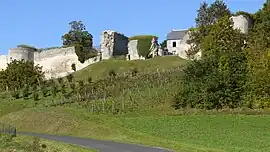Coucy-le-Château-Auffrique
Coucy-le-Château-Auffrique (French pronunciation: [kusi l(ə) ʃɑto ofʁik]; Picard: Couchi-Catieu-Aufrike) is a commune in the Aisne department in Hauts-de-France in northern France. Its population in 2020 was 992.[3]
Coucy-le-Château-Auffrique | |
|---|---|
 Ramparts | |
 Coat of arms | |
Location of Coucy-le-Château-Auffrique | |
 Coucy-le-Château-Auffrique  Coucy-le-Château-Auffrique | |
| Coordinates: 49°31′13″N 3°19′21″E | |
| Country | France |
| Region | Hauts-de-France |
| Department | Aisne |
| Arrondissement | Laon |
| Canton | Vic-sur-Aisne |
| Government | |
| • Mayor (2020–2026) | Sophie Boutroy[1] |
| Area 1 | 11.46 km2 (4.42 sq mi) |
| Population | 992 |
| • Density | 87/km2 (220/sq mi) |
| Time zone | UTC+01:00 (CET) |
| • Summer (DST) | UTC+02:00 (CEST) |
| INSEE/Postal code | 02217 /02380 |
| Elevation | 47–147 m (154–482 ft) (avg. 112 m or 367 ft) |
| 1 French Land Register data, which excludes lakes, ponds, glaciers > 1 km2 (0.386 sq mi or 247 acres) and river estuaries. | |
Geography
Coucy is located west of Laon on the road between Tergnier (north) and Soissons (south) north-northeast of Paris.
The river Ailette forms most of the commune's southern border.
Population
| Year | Pop. | ±% p.a. |
|---|---|---|
| 1968 | 1,137 | — |
| 1975 | 1,118 | −0.24% |
| 1982 | 1,120 | +0.03% |
| 1990 | 1,058 | −0.71% |
| 1999 | 995 | −0.68% |
| 2007 | 1,046 | +0.63% |
| 2012 | 1,058 | +0.23% |
| 2017 | 1,014 | −0.85% |
| 2020 | 992 | −0.73% |
| Source: INSEE[4][3] | ||
Personalities
- Henri Carette
- Moses ben Jacob of Coucy
- Samson of Coucy
- Louis-Xavier Gargan
- César de Vendôme, (born 7 June 1594)
- Ferdinand Stanislas Bigot (6 May 1809 – 1890), mayor of Coucy-le-Château in the 1870s
- François Pipelet de Leury, (1722–1809), director of the Royal Academic Surgery, doctor of the royal family, mayor of Coucy-le-Château for thirty years. Lieutenant of the first surgeon for the king.
- Enguerrand VII de Coucy
- Barbin Pierre Philibert (1819-1868) born in Coucy-le-Chateau, grandfather of the actor Rudolph Valentino.
Points of interests
- Ruins of the Château de Coucy. The modern town is squeezed into the space within the medieval walls.
- A medieval garden
- Domaine de la Grangère (a green space for the garden of the governor's house at the time) - landmark classified in 1931
- A church - rebuilt after World War I.
- The forest nearby Coucy is the place where the Paris Gun was located and first used in WWI.
References
- "Répertoire national des élus: les maires" (in French). data.gouv.fr, Plateforme ouverte des données publiques françaises. 13 September 2022.
- "Populations légales 2020". The National Institute of Statistics and Economic Studies. 29 December 2022.
- "Populations légales 2020". INSEE. 29 December 2022.
- Population en historique depuis 1968, INSEE
External links
Wikimedia Commons has media related to Coucy-le-Château-Auffrique.
- Official website
- http://www.amvcc.com
- Tourist guide to the town
- Arms of this town
- Collection of old postcards from Coucy
This article is issued from Wikipedia. The text is licensed under Creative Commons - Attribution - Sharealike. Additional terms may apply for the media files.